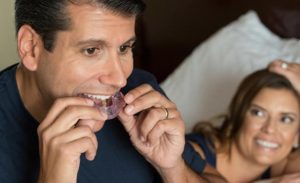A WASTE OF TIME?
February 27, 2023
 In an online report I recently read in a journal that was forwarded to me by a patient, they listed 9 “healthy” habits that they claim are a waste of time. Three of them had to do with oral health. Let’s take a look.
In an online report I recently read in a journal that was forwarded to me by a patient, they listed 9 “healthy” habits that they claim are a waste of time. Three of them had to do with oral health. Let’s take a look.
The first on the waste of time list was to see your dentist twice per year. I have seen this reported somewhere else in the media recently. According to the authors, close to 30 studies have apparently found no conclusive evidence supporting a need to see a dentist every 6 months. They went on to say, “If your teeth and gums are healthy, once per year is enough to catch developing problems.”
I absolutely agree. There are definitely people who only need to see a dentist/hygienist once per year. Most dentists use a classification system to rate a patient’s periodontal (gum) health. Type I patients are the ones that only need to see a dentist once per year. They are healthy, they have good homecare habits and are low risk for disease. In the average dental practice, I would say this is about 10-15% of the population.
Type II patients are those with gingivitis and should be seen twice per year. This group makes up about 50% of the typical dental patient population. Many of these patients could move into the Type I group if they had better homecare habits and technique.
Type III & IV patients are the remaining 30-35% of the population who should be seen every 3 or 4 months, and in some cases even more frequently. Because of genetics and/or bad habits, this group has active disease and is at high-risk for problems.
Let’s also not forget the other 50% of the population who don’t even visit a dentist once per year. While I think there are people who can be healthy and see a dentist once per year, it is irresponsible to make it seem that it pertains to everyone. The only one who can determine how healthy you are is your dentist. It should be up to you and the dentist you trust.
The #7 waste of time reported was to use a hard toothbrush. According to the report, a soft one cleans your teeth just as well and is less damaging to your teeth and gums. This is old news and is true.
The next one shocked me. The #8 waste of time – brushing and flossing twice per day. According to the authors, everyone only needs to visit the dentist once per year and brush and floss one time per day. They recommend brushing for at least 2 minutes before you go to bed and flossing one time per day. They also mentioned that people who did not floss frequently (whatever that means) are 3 times more likely to develop stomach cancer. I am assuming the author is relating lack of flossing to getting periodontal (gum) disease. More recent research is showing that, “Risk factors for precancerous lesions and gastric cancer are being identified, one of which may be periodontal disease”. Although lack of flossing does not automatically cause gum disease, poor oral health is clearly a risk factor for other health problems.
Here’s the bottom line:
- Establish a relationship with a dentist you are comfortable with and trust. Determine with that person how frequently you should be seen.
- Use a good quality soft electric toothbrush. Get instructions on proper use from your hygienist.
- Brush at least twice per day, preferably at least 30 minutes after meals. Floss or water pik at night before you brush.
It is as simple as that.
Dr. St. Clair maintains a private dental practice in Rowley dedicated to health-centered family dentistry. He has a special interest in treating snoring, sleep apnea and TMJ problems. If there are certain topics you would like to see written about or questions you have please email them to him at jpstclair@stclairdmd.com
BREATHING IS IMPORTANT – PART 2
February 21, 2023
 Last week I introduced Part 1 of “Breathing is Important”. For this week’s column to make the most sense, I would encourage you to read that column first. It can be found at www.thetowncommon.com.
Last week I introduced Part 1 of “Breathing is Important”. For this week’s column to make the most sense, I would encourage you to read that column first. It can be found at www.thetowncommon.com.
In case you don’t have a chance to read it, here is a brief recap: I have been involved in treating patients with sleep apnea for a few years. These are patients who have been diagnosed with sleep apnea or Upper Airway Resistance Syndrome (UARS) by a sleep doctor. Some patients are referred who have mild-moderate sleep apnea as first-line treatment, and others are unable or unwilling to use a Continuous Positive Airway Pressure (CPAP) machine.
There is clear evidence that sleep disordered breathing affects more people in more ways than was thought in the past. As the research continues, more people will be able to be helped to breathe and sleep better. It is healthier to breathe well.
Although there are many people with obstructive sleep apnea who need treatment, there are many others who have the same signs and symptoms as people with apnea and poor sleep, but they “pass” a sleep study. Many of these people may have UARS, which is a lower-level sleep breathing disorder. The treatment options are often the same, including weight loss, CPAP, or dental sleep orthotics.
In most cases, sleep related breathing disorders start early in development, and progress throughout life. It’s actually an evolutionary/developmental problem. Jaw development in humans has weakened. Our prehistoric ancestors had bigger jaws because they breast fed longer, and had to really chew the things they ate. They never needed their wisdom teeth taken out because their jaw was plenty big enough to accommodate them.
Dentists have an extremely important role in helping to identify sleep breathing disorders in all phases of life, especially in children, where most of these problems begin. Identifying them early can allow intervention through orthodontics and other non-invasive therapy, and completely change the course of development, leading to a life of better breathing and better health.
Because adults have stopped growing, we are stuck treating the problem, usually for the remainder of life. Treating this however, can increase quality and length of life for many patients who have a sleep breathing disorder. Identifying and treating airway issues, both early in life and in adults, as well as offering more advanced resolutions as research continues, is where medicine and dentistry must grow together.
Sleep apnea is the end stage of this breathing disorder. Currently, treatment for those with sleep apnea is typically either the “gold standard” of CPAP, wearing a dental sleep orthotic, Inspire (hypoglossal/tongue nerve stimulation), or major surgery to fix the anatomy that is causing this progressive disease. Medicine’s goal, however, should be to identify and treat airway issues early in life, so this end stage disease is never achieved.
You would be amazed at some of the things that are potentially related to breathing issues, such as ADHD, developmental issues, memory problems, TMJ pain, poor quality sleep, snoring, and a host of other things. While research in this area is ongoing, there is plenty of scientific evidence already out there to support this information. Breathe well.
Dr. St. Clair maintains a private dental practice in Rowley dedicated to health-centered family dentistry. He has a special interest in treating snoring, sleep apnea and TMJ problems. If there are certain topics you would like to see written about or questions you have please email them to him at jpstclair@stclairdmd.com
BREATHING IS IMPORTANT – PART 1
February 13, 2023
 About ten years ago I took a weekend course at Tufts University School of Dental Medicine entitled “Sleep Dentistry”. This was not a course in putting patients to sleep for their dental work. This particular course was an introduction to treating people who had been diagnosed with sleep apnea (a sleep breathing disorder) by a medical doctor, and could not (or would not) use the dreaded CPAP machine.
About ten years ago I took a weekend course at Tufts University School of Dental Medicine entitled “Sleep Dentistry”. This was not a course in putting patients to sleep for their dental work. This particular course was an introduction to treating people who had been diagnosed with sleep apnea (a sleep breathing disorder) by a medical doctor, and could not (or would not) use the dreaded CPAP machine.
CPAP, which stands for Continuous Positive Airway Pressure, is a facial mask which blows air through the nose to create an “air stent” to basically hold the airway open during sleep. It is the gold standard of treating sleep apnea and works well for many people, but not all.
Patients with sleep apnea have been diagnosed with a progressive disease in which breathing is decreased by a significant percentage for more than 10 seconds multiple times an hour. Most people know someone who has been diagnosed with this disease and either use a CPAP machine, or cannot use it.
The “sleep dentistry” part of the equation is that for those who have been diagnosed with sleep apnea and cannot use the CPAP machine, the next line of defense is a dental device. This is worn at night to hold the lower jaw slightly forward and not allow the jaw to fall back during sleep. Holding the lower jaw (mandible) forward helps to prevent the tongue from falling back in the mouth during sleep and obstructing the airway.
I was excited about this course I had taken at Tufts, and thought that I was going to start treating all these people I heard about who were not able to tolerate or didn’t want to use CPAP. The problem I found was that sleep apnea needed a medical diagnosis, which meant that patients had to have already had a sleep study with a physician, have failure in the use of CPAP, and then somehow find their way to my office. I was frustrated. I wasn’t treating that many patients, but knew (or at least thought), I must need more education.
So, in 2017 I enrolled in a mini-residency program at Tufts for 8 months. This was a much more intensive program with heavy emphasis on the science behind the disease. The program was great and I felt I had now “figured it out”.
I was much more knowledgeable about things to look for in patients, and was referring many patients to physicians to be evaluated. Some patients would end up having a sleep study, be diagnosed with sleep apnea, go on CPAP, and then come back to my office and say, literally, “you changed my life.” There is no greater feeling than that. Even though I didn’t get to treat them with my fancy dental appliance, they were being treated for a disease that was slowly (or not so slowly) killing them.
There were also those patients who had the sleep study, were diagnosed with sleep apnea, were not able to (or didn’t want to) use CPAP and were referred back to me for dental appliance therapy. Great!!! However, I quickly became frustrated again. Far too many patients, with classic symptoms such as snoring and daytime fatigue, were returning to me, saying they had a sleep study that showed they did not have apnea. Now what?
I’m a dentist, not a physician. Sleep problems are medical problems. And, although I knew that many of these patients may have sleep issues that were out of my control as a dentist (there are over 100 sleep disorders), many of these patients had dental signs such as wear on their teeth, grinding and/or clenching problems, TMJ pain, and other anatomic issues that I had learned about that were likely related to breathing problems. So, what did I do? I decided I needed more education. …….continued next week
Dr. St. Clair maintains a private dental practice in Rowley dedicated to health-centered family dentistry. He has a special interest in treating snoring, sleep apnea and TMJ problems. If there are certain topics you would like to see written about or questions you have please email them to him at jpstclair@stclairdmd.com
ARE YOU AT RISK?
February 6, 2023
 Last week I introduced you to a patient who has been struggling with dental decay (cavities), gum recession, and dental erosion (the chemical breakdown of tooth structure). I discussed how these dental problems are complex multifactorial diseases of epidemic levels affecting both children and adults.
Last week I introduced you to a patient who has been struggling with dental decay (cavities), gum recession, and dental erosion (the chemical breakdown of tooth structure). I discussed how these dental problems are complex multifactorial diseases of epidemic levels affecting both children and adults.
I ended with the idea that a healthy mouth requires more than brushing, flossing, and “fillings”. With current scientific evidence and new technologies, patients and practitioners need to begin to look at these problems not just from a drilling and filling approach, but also from a medical (preventive/therapeutic) approach. If “we” continue to think the same way about dental issues, we will continue to have the same struggles and same results.
There are over 19,000 different bacteria that have been found in mouths and every person has about 1,000 different types. Not all of them cause decay, but many of them have also been found to grow on artery walls. The medical/dental systemic connection is real and we must pay more attention to it.
Dental decay is on the rise. Why the increase? Most of it has to do with dietary trends. We snack more, eat more sugar/carbs, drink more soda, have more gastric reflux, take more mouth-drying medications, etc. Dental caries (decay) is a pH specific disease. The right bacteria, plus sugar, create acid, which breaks down the enamel of the teeth. Add an already acidic environment and it is even worse. In most cases it is a preventable disease. The problem is that changing our thinking and behavior, the nemesis of all that is good or bad, is difficult to do unless there is an awakening among us.
It is time for the dental professional to take a different approach when treating this disease. More focus needs to be shifted to prevention of decay, rather just treating it. Filling teeth is treating the result of the disease, but does nothing to prevent it. The dentist needs to take a more active role in assessing individual’s risk factors. In the dental world one way to do this is to use CAMBRA, which stands for Caries Management By Risk Assessment.
Based on assessing an individual’s risk factors such as quality of home care, quality of salivary flow, medication and dietary issues, a caries-preventive strategy can be established. Dentists must take some responsibility and be open to a different management of this disease. They must also be able to motivate people to change habits. The bottom line is that if you want to be decay-free, you can be.
For those at high risk, specific behavioral modifications are almost always necessary. To become aware of these often requires an assessment by your doctor. Doctors need to shift time away from treating things to be able to assess more, and discuss the specific behavior modifications necessary for each individual patient. The patient needs to be receptive to hear and act on these changes.
There are also some great products currently available, and others on the horizon. Everything from new toothpastes and gels with ions in them to rebuild tooth structure, sprays to neutralize pH, and probiotics are on their way. Right now you can use things like the sweetener replacement Xylitol, which by itself is cavity-fighting, but also works synergistically with fluoride. Prescription level toothpastes are also available, and there is strong research for the topical application of fluoride varnish (the same stuff the kids get) for adults.
The evidence is very clear – this is a preventable disease. Next time you go to the dentist and find out you have a new cavity, stop blaming the dentist or yourself, and ask to get a specific protocol for prevention of this disease based on your specific risk factors.
Dr. St. Clair maintains a private dental practice in Rowley dedicated to health-centered family dentistry. He has a special interest in treating snoring, sleep apnea and TMJ problems. If there are certain topics you would like to see written about or questions you have please email them to him at jpstclair@stclairdmd.com







